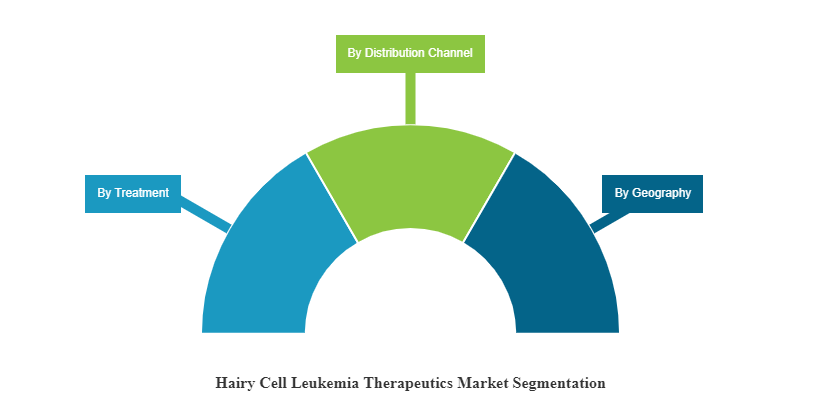Home / Healthcare / Hairy Cell Leukemia Therapeutics Market
Hairy Cell Leukemia Therapeutics Market Size, Share and Analysis by Treatment (Chemotherapy, Biological Therapy, Others), By Distribution Channel (Hospital Pharmacy, Retail Pharmacy, Online Pharmacy), and Regional Forecast, 2025-2032
Report Format: PDF | Published Date: Ongoing | Report ID: FBI100616 | Status : UpcomingHairy Cell Leukemia is a rare, slow-growing blood cancer that starts in the bone marrow, the soft tissue present inside some of the bones. Hairy Cell Leukemia occurs when the bone marrow produces too many B-cells or lymphocytes, a type of white blood cells which are responsible for immune response. These excess of B cells are abnormal and appear hairy under the microscope, hence the name of cancer. As the number of lymphocytes or B-cells produced increases, very few healthy white blood cells, red blood cells, and platelets are produced. This build-up of abnormal cells in the blood and bone marrow leads to the malfunctioning of how the blood of an individual behaves. Hairy Cell Leukemia is chronic blood cancer, and cannot be completely cured, but with medical care, the individuals diagnosed can live for a long time. Hairy Cell Leukemia occurs more commonly in females, and the symptoms include fatigue, easy bruising, recurrent infections, and weight loss. The causes of hairy cell leukemia are unclear, but some of the risk factors include exposure to radiation & toxins and DNA mutations.
The global hairy cell leukemia therapeutics market is anticipated to grow, owing to several factors such as the increased prevalence of rare cancer, efficient diagnosis, increasing geriatric populations, demand for the prevention of associated or second cancers, and high incidences of cancer amongst the rural population exposed to toxins through fertilizers. The American Cancer Society estimates that when patients diagnosed with Hairy Cell Leukemia are given therapeutics through chemotherapy, they give a good response that often lasts more than five years. Cancer Research UK also estimates that 90 out of 100 patients (90%), survive their leukemia for more than five years after successful treatment and move towards remission. Often if leukemia returns, the same course of treatment is administered, and if not successful, alternatives such as biological therapies are administered. This trend, combined with the other factors, is expected to positively drive the market.

The factors limiting the growth of the global hairy cell leukemia therapeutics market include the lack of awareness of cancer and its symptoms leading to lesser diagnosis, lack of medical facilities in rural areas and the absence of significant research studies.
KEY PLAYERS COVERED
Some of the major companies that are present in the global hairy cell leukemia therapeutics market are AstraZeneca, AbbVie Inc., Biogenomics Limited., F. Hoffmann-La Roche Ltd, Astellas Pharma Inc., Janssen Pharmaceuticals, Inc., and Juno Therapeutics.
SEGMENTATION
SEGMENTATION | DETAILS |
By Treatment | · Chemotherapy · Biological Therapy · Others |
By Distribution Channel | · Hospital Pharmacy · Retail Pharmacy · Online Pharmacy |
By Geography | · North America (USA and Canada) · Europe (UK, Germany, France, Italy, Spain, Scandinavia and Rest of Europe) · Asia Pacific (Japan, China, India, Australia, Southeast Asia and Rest of Asia Pacific) · Latin America (Brazil, Mexico and Rest of Latin America) · Middle East & Africa (South Africa, GCC and Rest of Middle East & Africa) |
The chemotherapy segment is estimated to dominate the global hairy cell leukemia therapeutics market during the forecast period owing to the increased research, the presence of potential pipeline candidates, and strategic collaborations.
KEY INSIGHTS
- Prevalence of hairy cell leukemia in key countries
- Pipeline analysis
- Patent snapshot
- New product launch
- Regulatory scenario for key countries
- Reimbursement Scenario for key countries
- Recent industry developments such as partnerships, mergers, and acquisitions
REGIONAL ANALYSIS
North America accounts for the largest share in the global hairy cell leukemia market due to the increased R&D spending, presence of advanced diagnostics, advancements in the treatment of hairy cell leukemia, and new product launches. In September 2018, AstraZeneca received FDA approval for Lumoxiti, intravenous injection for hairy cell leukemia, which is expected to accelerate the growth in hairy cell leukemia market in North America. Asia Pacific is the fastest growing emerging market due to increasing incidences, developing healthcare system, increasing awareness, aging population pools, and the adoption of advanced medical therapeutics.
Key Industry Developments |
· In September 2018, AstraZeneca received FDA approval for Lumoxiti, an intravenous injection for refractory or relapsed hairy cell leukemia. · In October 2018, Innate Pharma entered into a multi-term agreement with AstraZeneca which resulted in acquisition of commercialisation rights of Lumoxiti in the U.S. and Europe. · Astellas Pharma Inc. is conducting phase 1 clinical study on drug candidate AGS67E for treatment of patients with hairy cell leukemia. |
- Global
- 2023
- 2019-2022


